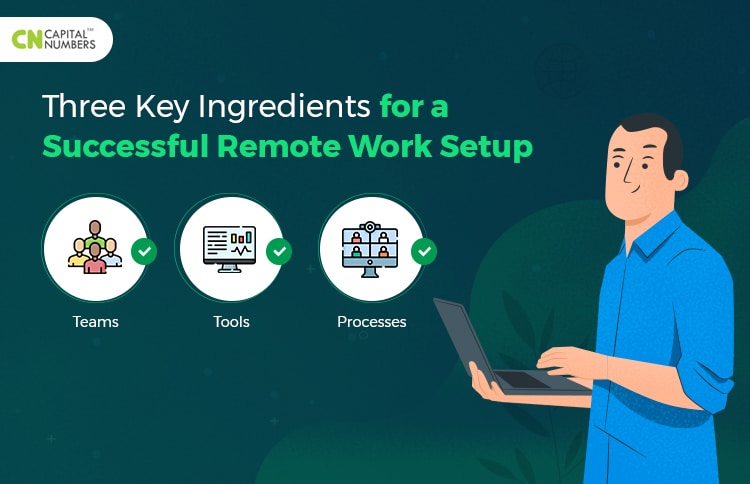Three Key Ingredients for a Successful Remote Work Setup
Table of Contents
With global shutdowns suddenly implemented overnight, we have all realized how quickly IT can move to a remote setup when it needs to. It is now time for businesses to build on that and prepare themselves for future agility.
Several forward-looking businesses have started revisiting their decisions to understand what works and what does not. Many started rethinking their quick fixes. Others have begun to look at new ways of doing things to keep their remote employees engaged.
In short, companies have been trying to find out key elements that can make remote work successfully work.
The three primary ingredients that we think are key to an effective remote work setup are:
- Teams
- Tools
- Processes
Let us look at each of these in detail below:
Teams
By far, the most critical ingredient for a successful remote work setup is the team. It is essential to assemble a team that can execute itself in a remote environment. Here is how you can form a powerful remote team:
| Hire people you can trust
Trust people you work with on the other end of the line, or work comes to a halt. |
Rely on work-from-home champions
Lean on candidates who have already worked in distributed teams in their previous roles. |
| Promote self-management
Choose team members that can self-regulate their time, workload, and other challenges. |
Encourage self-motivation Pick those who feel self-motivated to reach their goals and enjoy the flexibility of a remote setup. |
Tools
The next critical ingredient is the tool. You can always arrange for all-hands meetings in a physical office environment. But, in a remote work setup, you need practical tools for teams to come together. We have picked six such tools that can step up your teamwork:
| Slack
Use channels in Slack to centralize all your tasks and files so that your remote team stays aligned from anywhere. |
GitHub
Foster a community using GitHub that promotes collaborative coding for developers to build software. |
Zoom
Create your digital office using Zoom that lets your team reliably chat over video and audio conferences across devices. |
| GoToMeeting
Leverage GoToMeeting to experience the best-quality online meetings even when you are on the move. |
Google Meet Use Google Meet to hop on a discussion over a video/audio chat with one person or as many as 100 participants. |
Trello Organize your projects into boards using Trello and check who is working on what and monitor progress at one glance. |
Processes
The third ingredient is the process you put forth. Good processes provide a direction to get things done. They should be flexible enough for teams to follow. Here are a few procedures that you can implement to keep your teams proactive.
| A culture of shippability and support
Let your developers allocate a few days each month on product maintenance and keep the rest for product enhancement and release. This provides a cadence to a team’s work. |
Weekly meetings
Weekly meetings can help teams learn something new, provide demos, engage, and never miss priorities. |
| Monthly one-on-ones
Monthly one-on-ones can enable teams to check in on goals, gather feedback from managers, and decide on the upcoming actionable points. |
A culture of accountability
Discussing updates, every Friday can be a great way to understand what has been shipped that week and what needs to be shipped the week next – providing accountability to all. |
While there is no one-size-fits-all remote work solution, the above three ingredients can help you form a solid foundation for a distributed team. So, set the right pace with these three elements, especially when the future of work is remote.
The Future of Remote Work
| Around 77% of teams will have remote workers by 2028. (Source: Upwork) | Nearly 74% of CFOs will permanently move some of their employees to a remote setup. (Source: Gartner) |
What is clear is that even when the world returns to normal, industries will have changed dramatically. So, invest in strategies that can help you pivot on demand. If you have the right tools, teams, and processes, you will be able to adjust when the world needs you to.
If you already have established tools, processes, and resources in place and choose to extend your software team inexpensively, contact Capital Numbers.
We will assign the best-fit developers who can work alongside your team. We will bear most of the administrative costs and overheads for you. Plus, our vetted engineers can deliver custom solutions for you to sustain long term despite crises and odds.


 Web Development
Web Development Cloud Engineering
Cloud Engineering Mobile App Development
Mobile App Development AI/ML/GenAI
AI/ML/GenAI E-commerce
E-commerce Software Development
Software Development UI/UX
UI/UX QA
QA Dedicated Teams
Dedicated Teams











